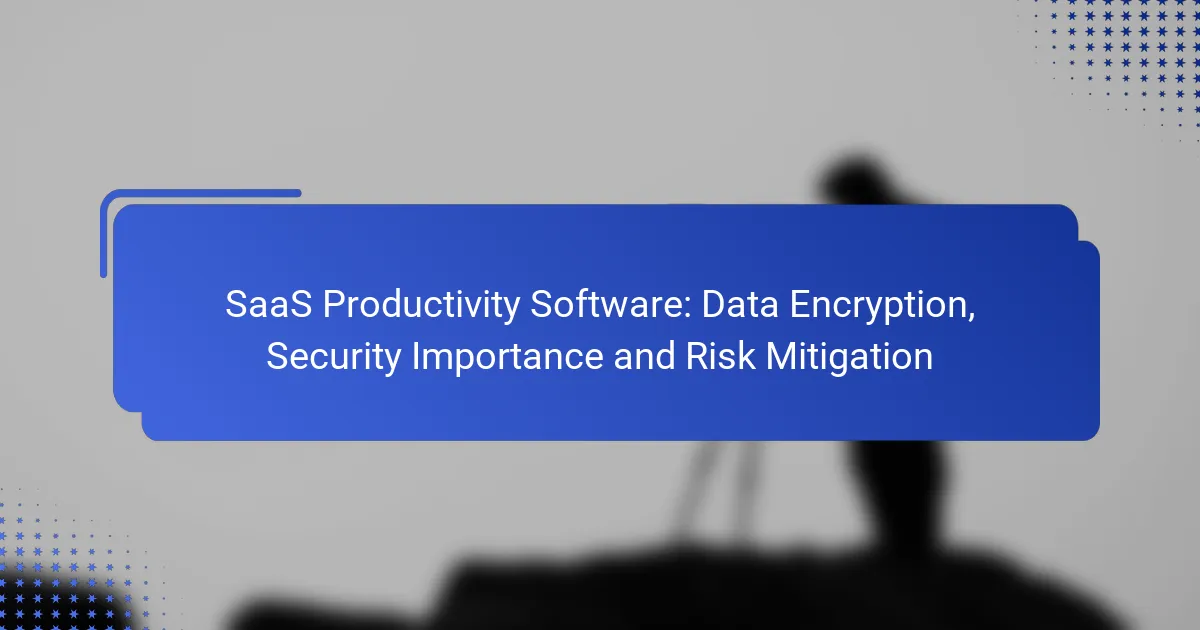In today’s digital landscape, the importance of data encryption in SaaS productivity software cannot be overstated, particularly in Canada where compliance with local regulations is crucial. By converting sensitive information into unreadable formats, encryption safeguards data both in transit and at rest, significantly mitigating risks such as unauthorized access and data breaches. Utilizing robust encryption solutions from providers like Microsoft 365, Google Workspace, and Box is essential for protecting sensitive information and maintaining trust with customers.
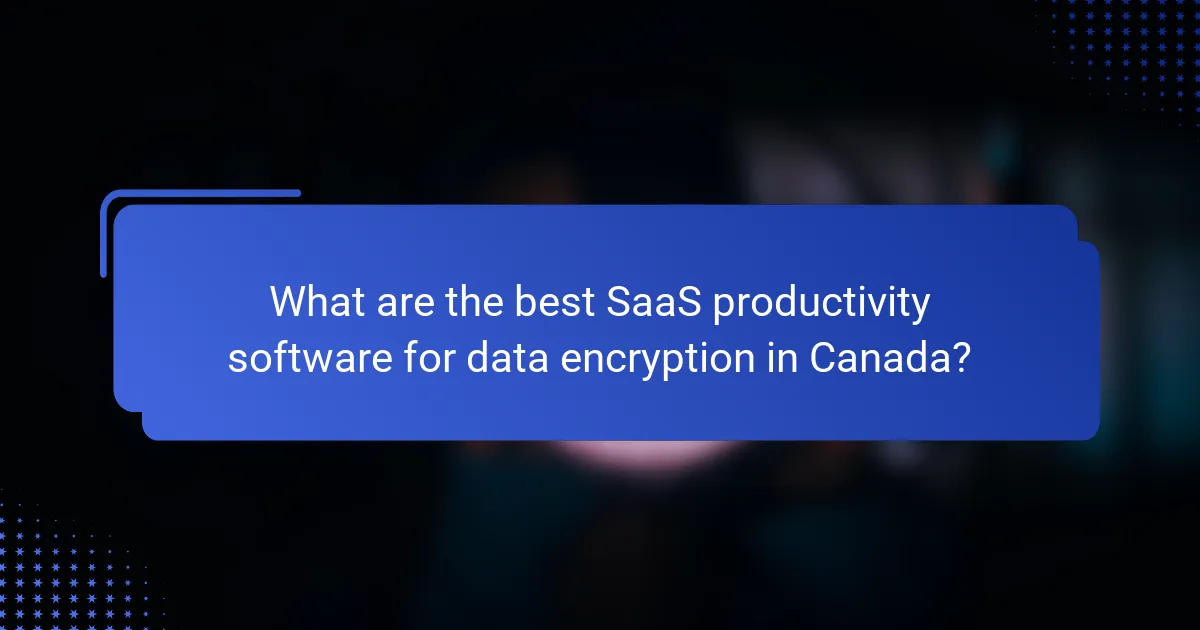
What are the best SaaS productivity software for data encryption in Canada?
The best SaaS productivity software for data encryption in Canada includes solutions that prioritize security features and compliance with local regulations. Key options such as Microsoft 365, Google Workspace, and Box offer robust encryption capabilities to protect sensitive data.
Microsoft 365 with Advanced Threat Protection
Microsoft 365 provides Advanced Threat Protection (ATP) to enhance data security through proactive threat detection and response. ATP includes features like Safe Links and Safe Attachments, which help safeguard against phishing and malware attacks.
When using Microsoft 365, ensure that encryption is enabled for emails and files stored in OneDrive and SharePoint. This ensures that data remains secure both in transit and at rest, complying with Canadian privacy regulations.
Google Workspace with Data Loss Prevention
Google Workspace incorporates Data Loss Prevention (DLP) to help organizations prevent the accidental sharing of sensitive information. DLP policies can be customized to automatically scan and protect data based on predefined rules.
In Canada, utilizing Google Workspace’s DLP features allows businesses to enforce encryption for emails and files, minimizing the risk of data breaches. Regularly review and update DLP settings to adapt to changing compliance requirements.
Box with Encryption at Rest
Box offers encryption at rest, ensuring that files stored on its platform are protected from unauthorized access. This feature is crucial for organizations handling sensitive data, as it encrypts files using strong algorithms.
For Canadian users, Box complies with data protection laws, making it a reliable choice for secure file sharing and collaboration. Consider implementing additional security measures, such as two-factor authentication, to further enhance data protection.

How does data encryption enhance security in SaaS applications?
Data encryption significantly enhances security in SaaS applications by converting sensitive information into unreadable formats, which can only be accessed by authorized users with the correct decryption keys. This process protects data both in transit and at rest, reducing the risk of unauthorized access and data breaches.
Protects sensitive information
Encryption safeguards sensitive information such as personal data, financial records, and proprietary business information. By encoding this data, even if it is intercepted during transmission or accessed from a compromised server, it remains unintelligible to unauthorized individuals. For instance, using AES (Advanced Encryption Standard) with a 256-bit key is a common choice for robust data protection.
Organizations should prioritize encrypting data that is classified as sensitive or confidential. Implementing encryption protocols not only protects this information but also builds trust with customers and stakeholders by demonstrating a commitment to data security.
Prevents unauthorized access
By employing encryption, SaaS applications can effectively prevent unauthorized access to data. Only users with the correct decryption keys can access the original information, making it difficult for hackers to exploit stolen data. This is particularly crucial for applications that handle sensitive transactions or personal user information.
Additionally, using multi-factor authentication alongside encryption can further enhance security. This combination ensures that even if an attacker gains access to a user’s credentials, they would still require additional verification to access the encrypted data.
Ensures regulatory compliance
Data encryption is often a requirement for compliance with various regulations, such as GDPR in Europe or HIPAA in the United States. These regulations mandate that organizations protect personal data through appropriate security measures, including encryption, to avoid hefty fines and legal repercussions.
To ensure compliance, organizations should regularly review their encryption practices and stay updated on relevant regulations. Implementing encryption not only helps in meeting legal requirements but also enhances the overall security posture of the organization, reducing the risk of data breaches and associated penalties.

What are the risks of not using data encryption in SaaS?
Not using data encryption in Software as a Service (SaaS) exposes sensitive information to various risks, including unauthorized access and data breaches. Without encryption, data transmitted and stored can be easily intercepted or accessed by malicious actors, leading to significant consequences for businesses and their customers.
Data breaches and leaks
Data breaches and leaks are among the most severe risks associated with the absence of encryption in SaaS applications. When sensitive data, such as personal information or financial records, is not encrypted, it becomes vulnerable to cyberattacks. A successful breach can lead to the exposure of thousands of records, resulting in immediate financial loss and long-term damage to a company’s reputation.
To mitigate this risk, organizations should implement strong encryption protocols for data at rest and in transit. Regular security audits and vulnerability assessments can help identify potential weaknesses in the system before they are exploited.
Loss of customer trust
Failing to encrypt data can lead to a significant loss of customer trust. Customers expect their information to be protected, and any incident involving data exposure can erode confidence in a brand. Once trust is lost, it can be challenging to regain, potentially resulting in decreased customer loyalty and revenue.
To maintain customer trust, companies should communicate their data protection measures transparently. Regular updates on security practices and compliance with industry standards can reassure customers that their data is safe.
Legal penalties and fines
Not adhering to data protection regulations due to a lack of encryption can result in legal penalties and fines. Many jurisdictions have strict laws regarding data privacy, such as the General Data Protection Regulation (GDPR) in the European Union, which imposes heavy fines for non-compliance. Companies that fail to protect sensitive data may face significant financial repercussions.
To avoid legal issues, organizations should stay informed about relevant regulations and ensure that their data protection strategies, including encryption, comply with legal requirements. Regular training for employees on data security practices can also help minimize risks associated with non-compliance.
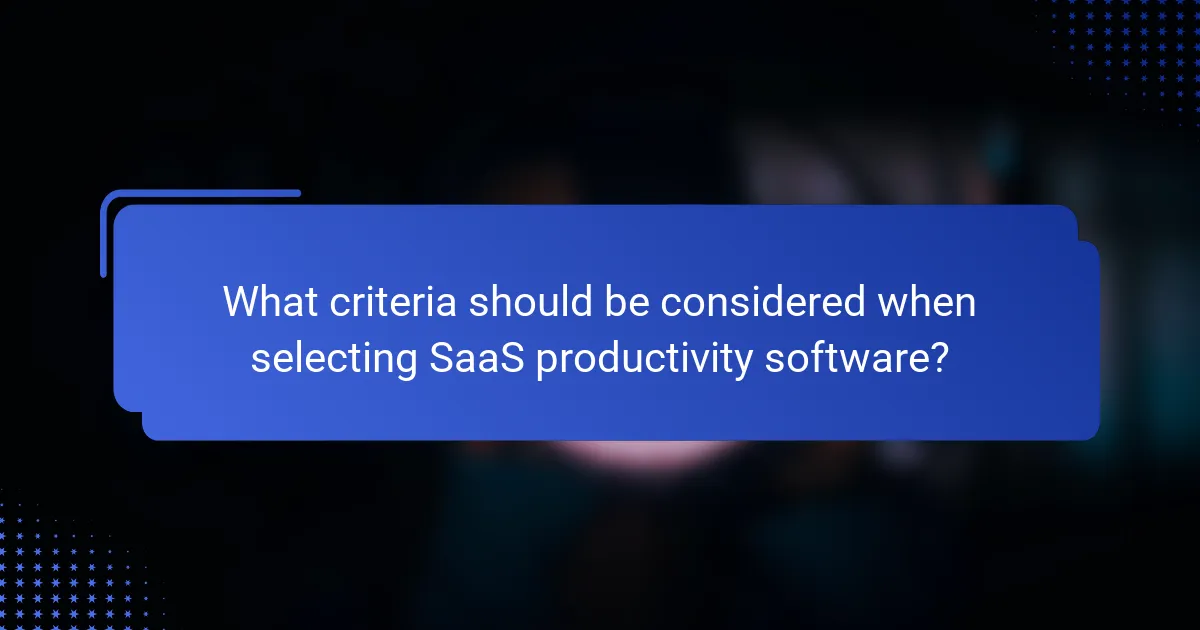
What criteria should be considered when selecting SaaS productivity software?
When selecting SaaS productivity software, it’s crucial to evaluate factors such as data encryption, integration capabilities, and scalability. These criteria ensure that the software meets security standards, works well with existing tools, and can accommodate your organization’s growth.
Encryption standards and protocols
Encryption standards and protocols are vital for protecting sensitive data in SaaS applications. Look for software that employs strong encryption methods like AES-256 and TLS for data in transit. These standards help safeguard information from unauthorized access and breaches.
Additionally, verify if the software complies with relevant regulations such as GDPR or HIPAA, which may dictate specific encryption requirements. This compliance not only enhances security but also builds trust with users and stakeholders.
Integration capabilities with existing tools
Integration capabilities are essential for ensuring that new SaaS productivity software can seamlessly connect with your current systems. Check if the software offers APIs or pre-built connectors for popular tools like CRM, project management, and communication platforms.
Effective integration can streamline workflows and reduce data silos, enhancing overall productivity. Prioritize solutions that support single sign-on (SSO) and data synchronization to simplify user management and maintain data consistency across platforms.
Scalability and user limits
Scalability refers to the software’s ability to grow with your organization. When evaluating SaaS options, consider how many users the platform can support and whether it can handle increased data loads as your team expands. Look for solutions that offer flexible pricing plans based on user count or usage levels.
It’s also wise to assess the software’s performance under load. Solutions that maintain speed and reliability with a growing number of users will help prevent disruptions and ensure a smooth user experience as your organization scales.
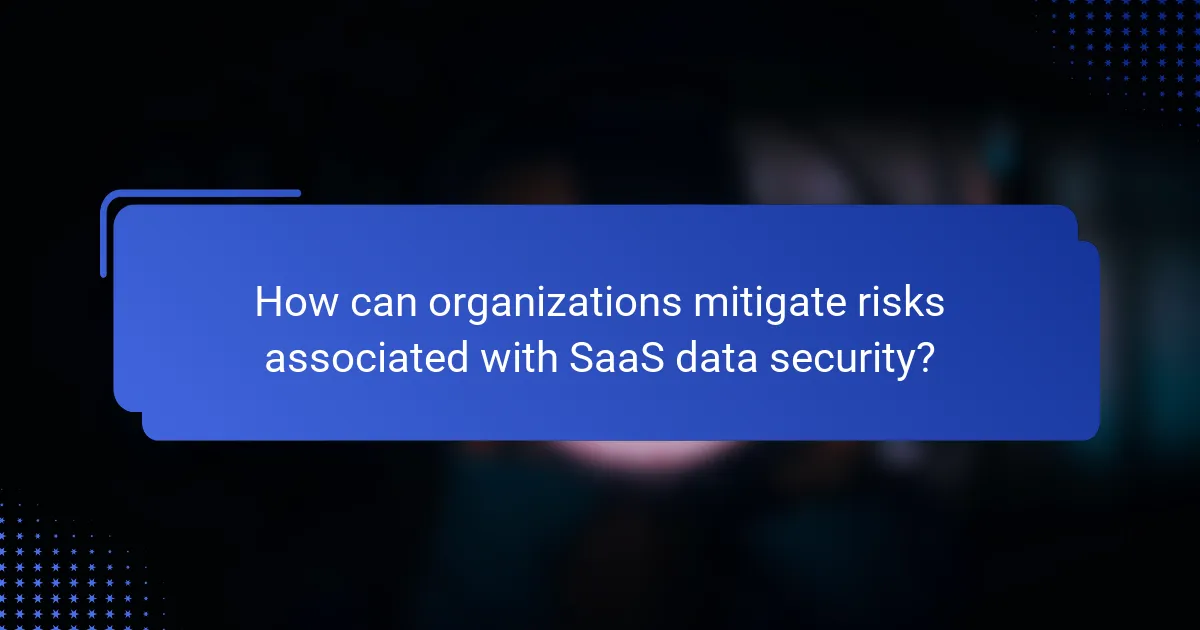
How can organizations mitigate risks associated with SaaS data security?
Organizations can mitigate risks related to SaaS data security by implementing robust security measures, conducting regular assessments, and ensuring employees are well-trained in data protection practices. These strategies help safeguard sensitive information and reduce vulnerabilities in cloud-based environments.
Implement multi-factor authentication
Multi-factor authentication (MFA) adds an extra layer of security by requiring users to provide two or more verification factors to gain access to SaaS applications. This could include something they know (like a password), something they have (like a smartphone), or something they are (like a fingerprint).
Organizations should encourage the use of MFA across all critical applications. This approach significantly decreases the likelihood of unauthorized access, as even if a password is compromised, additional verification is needed to breach security.
Regular security audits and assessments
Conducting regular security audits and assessments helps organizations identify vulnerabilities in their SaaS applications and overall security posture. These evaluations should include penetration testing, vulnerability scans, and compliance checks against industry standards.
Organizations should schedule these audits at least annually, or more frequently if significant changes occur in their infrastructure or threat landscape. This proactive approach enables timely remediation of issues before they can be exploited by malicious actors.
Employee training on data security
Training employees on data security is essential for fostering a culture of awareness and vigilance. Regular workshops and training sessions should cover topics such as recognizing phishing attempts, safe password practices, and the importance of data encryption.
Organizations should implement ongoing training programs, as threats evolve rapidly. Providing practical examples and simulations can enhance understanding and retention, ensuring that employees are equipped to protect sensitive data effectively.
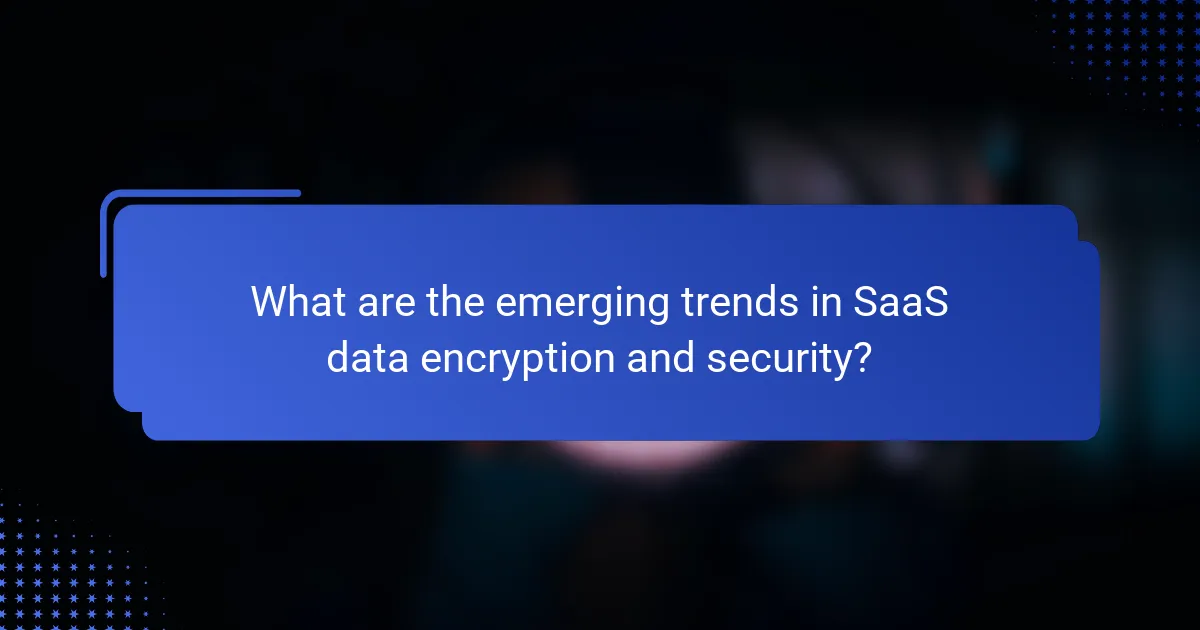
What are the emerging trends in SaaS data encryption and security?
Emerging trends in SaaS data encryption and security focus on enhancing protection against evolving threats. Key developments include the integration of artificial intelligence, the implementation of zero-trust models, and the rise of end-to-end encryption solutions.
Increased use of AI for threat detection
The use of artificial intelligence in threat detection is becoming more prevalent in SaaS environments. AI algorithms can analyze vast amounts of data in real-time, identifying unusual patterns that may indicate security breaches.
Organizations are leveraging machine learning to improve their security posture. By continuously learning from past incidents, AI systems can adapt and respond to new threats more effectively, reducing the time to detect and mitigate risks.
Adoption of zero-trust security models
Zero-trust security models are gaining traction as organizations recognize the need for stricter access controls. This approach assumes that threats can originate from both outside and inside the network, requiring verification for every user and device attempting to access resources.
Implementing a zero-trust model involves segmenting networks, enforcing least privilege access, and continuously monitoring user behavior. This strategy helps to minimize potential damage from breaches and enhances overall security resilience.
Growth of end-to-end encryption solutions
End-to-end encryption (E2EE) solutions are increasingly being adopted to ensure that data remains secure from the point of origin to the final destination. This method encrypts data in transit and at rest, making it accessible only to authorized users.
Organizations should consider E2EE for sensitive communications and transactions, as it significantly reduces the risk of data interception. However, implementing E2EE can introduce complexities in data management and compliance, so careful planning is essential.
